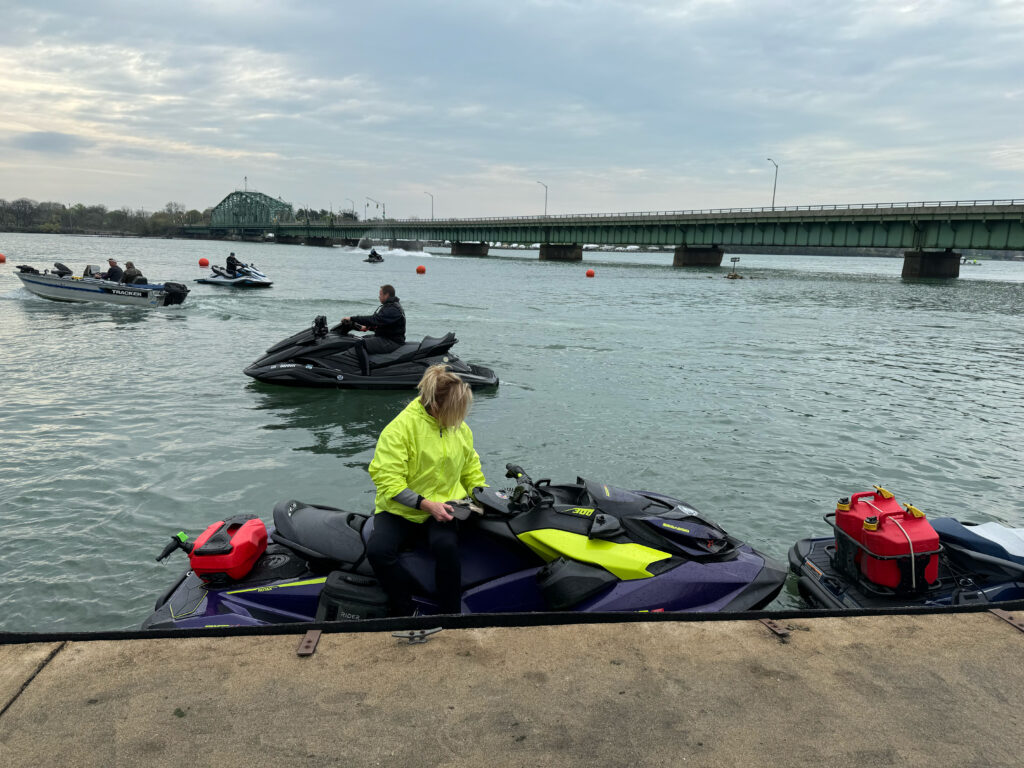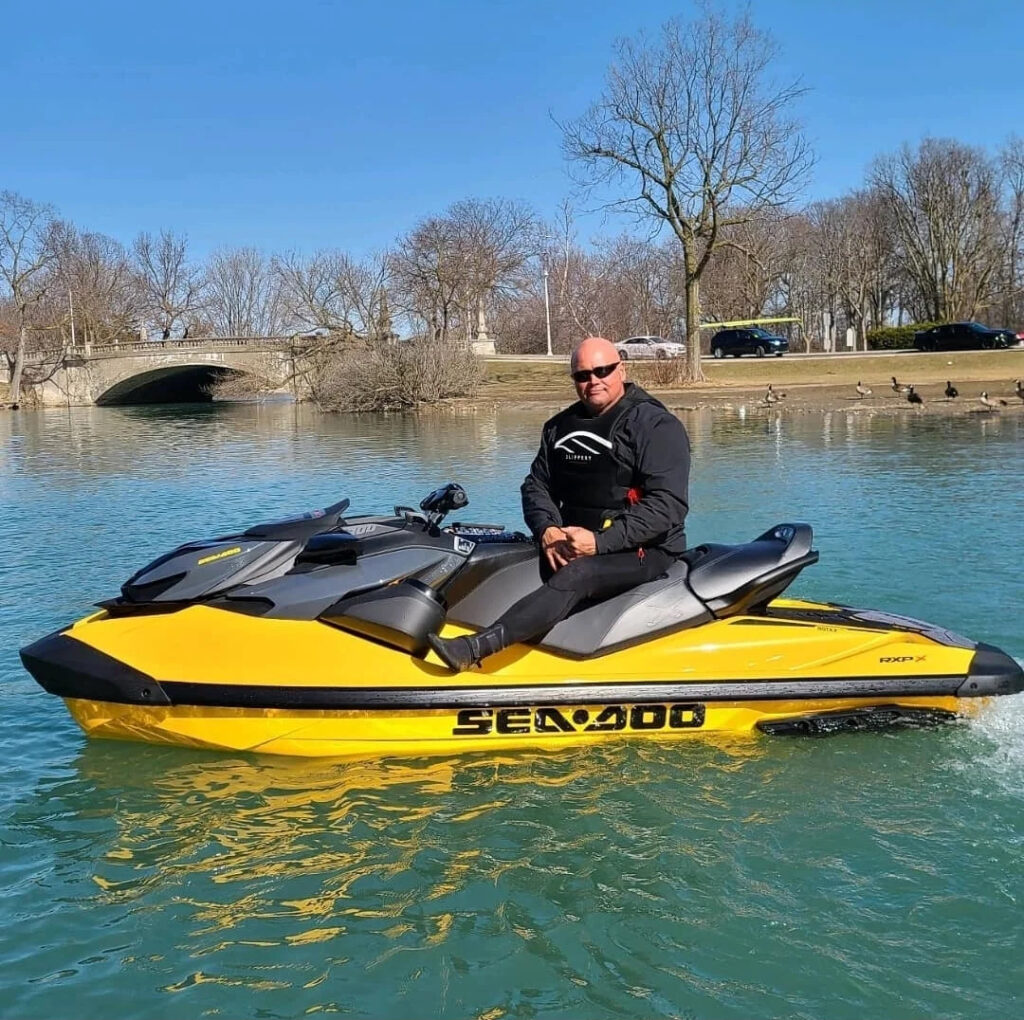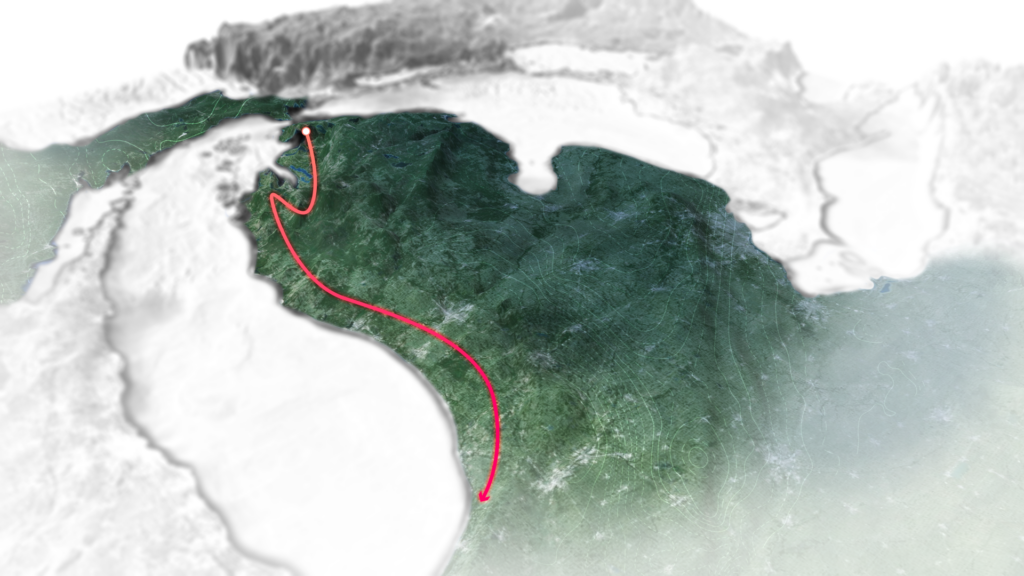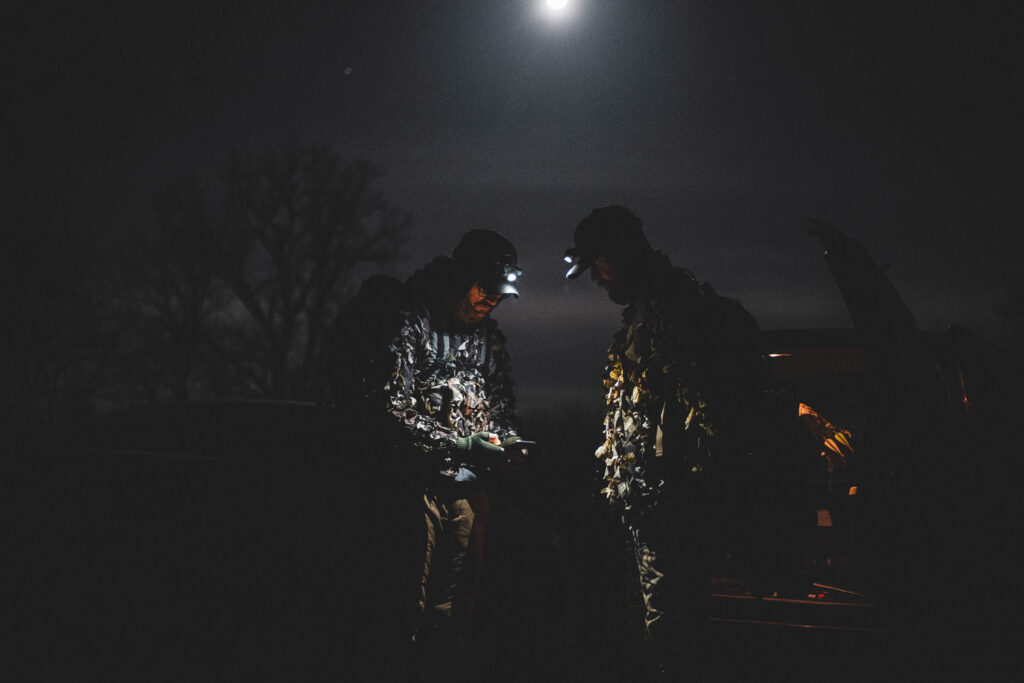Not every adventure starts with excitement. The gatekeeper at Elizabeth Park Marina insists on cash; he won’t take my credit card, the equivalent amount in Canadian cash, or defer my payment till later. Now I’m driving around Trenton, Michigan, frantically searching for a bank machine. I can’t find one. Eventually, Joe Cornett and Gabrielle Taub—the two main organizers of the Great Lakes Ski Riders—call to inform me they’ve paid my entrance fee.
“He’s an a**hole,” Gabrielle confirms. Earlier that morning, an elderly man had parked while the attendant had absconded from his post. But the gate was open, and using a cane, the old man took almost 20 minutes to shuffle his feet from his parking spot toward the dock on the Detroit River.
Upon his return, the attendant chased down the hobbling veteran to demand immediate payment. Infirm and tired, the veteran needed to sit and recover, assuring the gatekeeper he would pay on his way out. It would not do, and the attendant called the police. When they arrived, the police excoriated the gatekeeper instead of the geriatric.

The water is cold. I throw on my wetsuit. Everyone is waiting for me, floating and idling on the yellow and green machines like patient mallards. The engines are loud. Fumes rise from their rears. Their exhaust mixes with smoke from burning cigarettes. The jet skiers light up inside their life jackets to shelter from the wind. They wear sunglasses to protect their eyes from spray, or perhaps the forecasted rain. I haven’t introduced myself yet, but I like them, because they look cool—dark shades, countless cigs, and fast vehicles.
Everyone is here for the annual Kickoff Ride. The plan is to ride West along the river, making our way towards Detroit, where we’ll see Henry Ford’s old estate, some automotive plants, and the nearly constructed Gordie Howe Bridge.
There’s a little terminology controversy when it comes to the personal watercraft (PWC). Kawasaki calls them Jet Skis. Bombardier uses the name Sea-Doo. Yamaha claims the WaveRunner. Mechanically, they are the same: an engine pulls water in through an impeller and then pushes the water out. Everyone I am riding with uses the term “ski” to avoid brand-specific language.
I mount the rear seat of Gabrielle’s ski. I’ll have to hold her waist for support while she drives—I’m not feeling especially alpha. We drift along shore, waiting for two other riders to arrive, getting dragged along with the river’s current, which flows from Lake St. Clair to Lake Erie. The river pulls us under the bridge that connects mainland Michigan to the Grosse Ile (“Big Island”). Cars drive directly over us on the road made from bar grating, exposing their nether region—I’m looking up their skirts.
Over a dozen riders travel with us, some who have traveled across the country, and most have a supercharged ski that can go over 80 mph in glassy conditions. Engines upgraded to accelerate faster than factory default. Waterproof speakers blare music synchronized to their smartphones. Aftermarket mounts hold GoPros and Insta360s. A few have jerry cans filled with 93 Octane fuel, secured on the stern in custom frames, in case someone runs dry. This all costs a lot of money. But it’s not a hobby, it’s an obsession.
In my high school years, I used to ride a WaveRunner around Lake Huron every day of the summer. In my lakefront hometown, a rental company had just opened. The owners wanted someone to drive around the many nearby beaches to advertise how much fun one could have on these things. It was tough work, riding around sand beaches, across vast water, in nothing except swimwear, with an unlimited supply of gasoline. But someone had to do it.
The ski my employer gave me was the newest at the time. It was mid-range and didn’t have any of the features of today’s top of the line, which is what Kickoff Riders have. Whenever I needed to idle, I would have to physically pull up a lever to point the thrusters in reverse, and then replace the lever—alternating forward-backward-forward-backward—to keep myself from moving in either direction. Otherwise, there was an ignition, the throttle, and one button to kill the engine. In comparison, these new toys have an entire dashboard of buttons, including options to forward, idle, reverse. You can adjust the trim, raising or lowering the bow of the watercraft, like hydraulics on a lowrider.
The Great Lakes Ski Riders are all being led by Joe Cornett, who, besides riding PWCs at every possible chance, is a crane operator. He tells me that once he retires—soon—this is all he’s going to do. “I’m going to travel all around the world and ski all day,” he says.

He looks a lot like Vic Mackey from The Shield, maybe a little stockier, and what’s more uncanny, he has the same voice. He’s commanding and charismatic. When someone is lost, or a machine breaks down, or someone isn’t feeling well, Joe is the problem solver. His head is perfectly bald, like a shiny bowling ball, which makes him more authoritative. Everyone here has tremendous respect for him, and it takes only a few moments with him to understand why. He is a natural leader.
Gabrielle tells me that many people come to Joe at their lowest: often depressed; sometimes suicidal. I am told that he has convinced many to abandon their unhealthy habits.
Joe has just returned from riding rivers in Florida. “When someone fell into the river there, you’d have to drum on the side of your ski to scare away the alligators, to buy some time for the guy to get back onto his machine,” he explains. He claims they maneuvered so close to alligators that a rider would only have a few seconds to splash around or else he’d get torn in half by hungry jaws. A leader…and an adrenaline junkie.
And, like many similar dopamine hunters, I suspect that a good number of the riders here are addicts in recovery. They give hints, some more subtle and others less so. They chain smoke like people loitering outside an AA meeting. Joe told me on the phone before I arrived, “We don’t drink, we don’t do drugs, but we ride hard.” Then there are suggestive anecdotes. Many riders cry after their first ride with Joe. A woman tells me that skiing with him has saved her life. And she really means it. Her redemption suggests more than a little fun and some community; it suggests a life on the mend. Certainly trauma. Maybe drugs. But I couldn’t ask many probing questions over the roar of 325 horsepower.
I have known many addicts. A teacher will tell her students that drugs are bad because they are bad; an addict will explain that drugs are bad because they are so good. Even when homeless, diseased, disfigured, ruined, and crippled—drugs have convinced tens of millions of Americans that, no, giving up the stuff won’t make them happier. No doubt, this hijacking of the mind, so deceptive and seductive, is the method by which psychoactive substances ensnare their users. Addiction must be understood in its own terms. And almost anyone recovering will admit that sobriety can come with a certain emptiness; a void that needs to be filled with obsessions, thrill, narrative, and overwhelming fun.

The irony is that, at this very moment, I am not having any fun. I’m sitting on the back of Gabrielle’s ski while she’s driving. As a passenger, I’m passive and just trying to get some footage. We ride to several locations, at which we stop each time and take group pictures. Whenever a camera emerges, everyone throws up the hang-loose, pinky-and-thumb gesture. As the only person “riding bitch,” my energy does not match theirs. I’m actually starting to feel bored. Guilty, too, for feeling bored when my hosts are so generous.
But just as I am losing hope, Gabrielle offers me a chance to drive her machine. It’s very kind of her to take such risks with a stranger. I’d guess her supercharged machine cost well over 30 grand.
It’s my turn, and it’s perfect timing because a storm is rolling in. The sky becomes black, as sinister clouds intercept the sun. The water turns from a warm teal, not far off in color from the Aegean Sea, to a cold reflective gray, like liquid mercury. The swells grow large and steep. The wind howls without needing to catch a breath. It feels like the lake has become alive, transforming from a lifeless geographical thing into a fantom spirit, both intentional and cruel.
We aren’t going to make it to Detroit. We have to turn around.
Some of the other riders are scared, because the swells roll in from every direction. They get tossed around unpredictably, back and forth, side to side, like yellow duckies in a toddler’s bathtub during a tantrum. The best way to handle the waves is to aim directly into them. That way, there’s no lateral movement, and the ski is less likely to tip over. But you will catch flight, and you’ll know you’re airborne when you hear the nagging hum of the impeller, previously muted underwater.
The waves seem intent on drowning you, and launching into the storm feels like a confrontation between the brilliance of the engineer and the violence of Mother Nature. This is when I enjoy riding the most. When the lake is calm, there is a disharmony between the pleasant serenity of nature and the mechanical roar of the ski. You disturb the peace. Groups of men, out on their fishing boats, scowl and yell when a ski speeds by, scaring the fish. But when there is a vicious storm, the growl and speed of a ski matches the brutality of the lake.
The lake will sometimes win.
Riding around Mud Island, across from the city of Ecorse, a heavier guy flips his ski and flies into the water. As precaution, ski riders have a magnetic kill-switch that fastens to the driver’s lifejacket. When the rider falls off, the magnet is pulled free, and the engine stops to prevent the machine from ghost-riding away. Not everyone uses this simple safeguard. Fortunately, our airborne friend had attached his safety lanyard. With his long neckbeard, his arms spread wide like wings, and while skimming the surface of the water, he looks like a flying catfish.
But he certainly doesn’t swim like one. He isn’t wearing a wetsuit and starts to hyperventilate. The water is less than 40 degrees. I tell him to calm down. I tell him that I’m an ice swimmer, but he begins thrashing in the waves. I encourage him to slow his breathing, and I explain that he’s more likely to drown by floundering. But he’s beyond advice and submits to his survival instincts. So, I give him the stern of Gabrielle’s ski. He can’t get up. He’s too big. I try to give him my hand, to hoist him, and even with my help, he hardly moves. His eyes are sharp with panic and focus, but he slips despite his effort and my help. I jump to another ski, switching with Gabrielle. With less weight on the machine, and with more help from other friends, he eventually climbs out from the frigid lake. Fortunately, the air is very warm. He removes his wet clothing to better dry off, and his skin turns salmon pink from the reperfusion of blood. He will be fine.
More than fine. In a few moments, he will be riding and laughing again and forget that, without our help, he would have caught hypothermia and died. He will instead shiver away the cold and shrug away the terror. This amnesia can be good and bad. On the one hand, the point is to escape reality by “becoming one” with the machine, which means becoming oblivious to the fact that the ski is something else. But on the other hand, there can be a rude awakening when, thrown from the seat and physically incapable, there is sudden disassociation.

Recreational machines amplify our athletic ability. They allow us to accelerate harder, turn quicker, jump higher, and become more agile. We like them for that reason, not because they are useful but because they are fun. In fact, PWCs, and every other species of recreational vehicle, are called the kid-word, “toys,” and not the adult-word, “tools,” because they bring us back to the naïve joy of childhood.
Trauma. Addiction. Mental illness. These are big concepts in the modern brain, but the American mind is altogether too self-conscious and neurotic. Of course, patented treatments will be sold by every therapist and psychiatrist—who seem to overly complicate everything to justify their expensive credentials.
But maybe our complicated problems are better addressed with simple solutions—and these Michigan riders seem to have stumbled upon a good cure while chasing the endless horizon: some innocent fun with good friends and a touch of danger. Maybe that’s all you need.
The storm is passing over as we return to Elizabeth Park Marina. On the dock, a woman named Sally tells me how she got into skiing. A few years ago, suffering from depression and weight gain after a divorce, her doctor had prescribed drugs for depression, anxiety, and ADHD. She met Joe around the same time. He recommended skiing as a treatment instead. “He told me,” Sally recounts, “that you’ll get a natural high from the exhilaration, and that by the end of the day, you’ll be so tired from the exercise, you’ll sleep easy.”
Very soon after her first day skiing with Joe, Sally replaced her antidepressants and anxiolytics with weekend rides. “I don’t take them anymore,” she says proudly, getting back on her ski.
After all, prescription pills dissolve in swirling water.
Mitch Miller is an adventure writer and conflict journalist. He’s more than happy to join in on any extreme activity, and can be reached at mitchenjoyer@gmail.com. Follow him on X at @funtimemitch.




